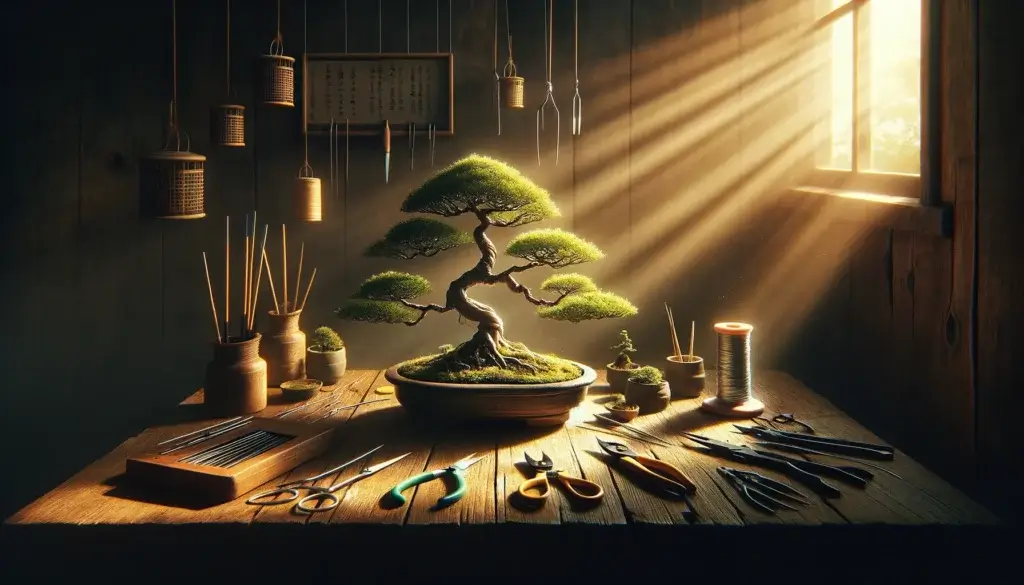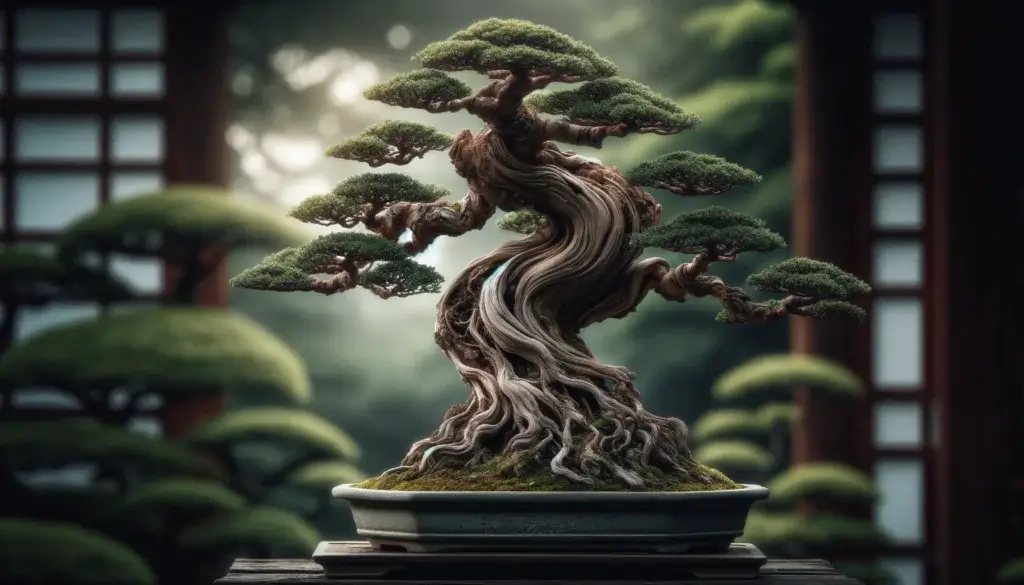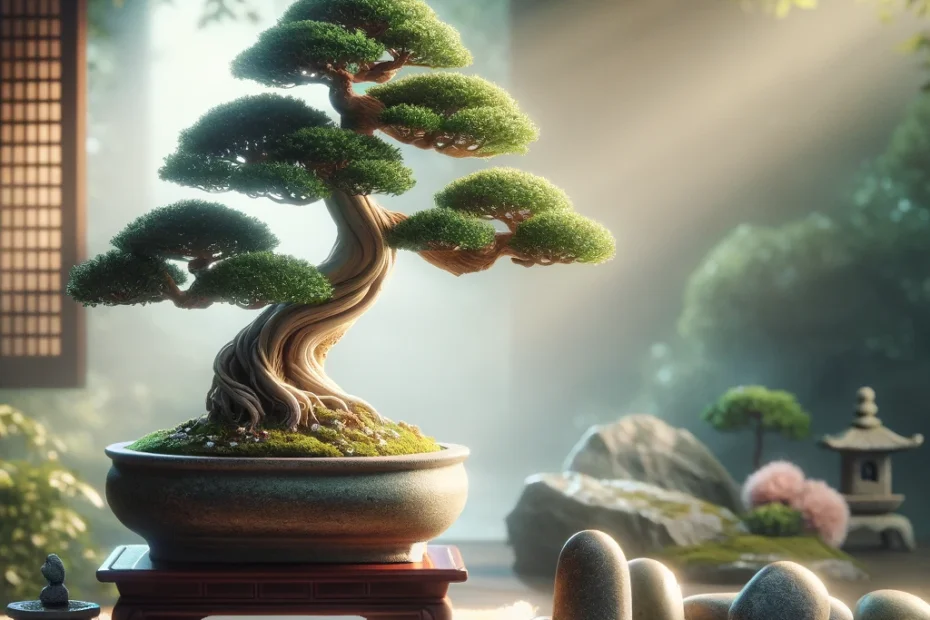
Bonsai, the art of aesthetically crafting miniature trees, is about far more than just sculpting small plants. It embodies core teachings shared across schools of Zen Buddhism, Taoism, wabi-sabi, and more. The thoughtful cultivation process awakens deeper connections to nature, stillness, beauty, and oneself.
In this beginner-friendly guide, we’ll decode the key aesthetic guidelines, symbolic meanings, meditative gains, and core philosophies that define bonsai. You’ll gain an insider perspective into this multidimensional art form blending science and spirituality.
Let’s prune away misconceptions, plant wisdom, and watch your appreciation for these petite natural artworks blossom!
Core Philosophies Embedded Within Bonsai

On the surface, bonsai seem like simple potted plants. But they contain layers of meaning tied to ancient Far East traditions.
Zen Buddhism
Bonsai’s cultivation echoes Zen notions of finding enlightenment through simplicity, patience, focus, and intuition rather than force. The practice teaches non-attachment and harmony with nature’s environments.
Taoism
Bonsai aesthetics reflect Taoist emphasis on humanity’s place within (not above) the natural order. Caretaking tiny ecosystems shows respect for the unpredictable yet balanced flows and changes of life.
Wabi-Sabi
The Japanese wabi-sabi philosophy treasures imperfection and constant flux within nature. Bonsai highlights natural asymmetry, irregularity, and imperfections as beautiful.
Meditation
The quiet, focused attentiveness bonsai care requires brings stillness to busy minds. Methodical rituals induce calm mindfulness of each passing moment.
Through this unique art form, fundamental teachings that shape Eastern consciousness take tangible shape. Miniature trees contain a microcosm of the world.
Crafting Miniature Natural Art Through Aesthetic Principles

Experienced bonsai artists apply keen aesthetics when coaxing life from tiny plants. Their goal? Condensing grand natural beauty into miniature while obeying botanical limits. Core design principles include:
🌳 Mimicking Mature Trees
Well-done bonsai captures aged trees’ gnarled bark, swaying branches, and time-sculpted shapes within miniature frames.
🍃 Complementary Foliage
Leaf size, color, and density must suit selected tree species and contain proportions.
📐 Balanced Structure
Asymmetrical triangular silhouettes framed by proportional negative space appeal most.
🛤️ Flowing Lines
Curving trunks and branches guide the eye deeply through layers of foliage.
⚙️ Spaced Branches
Leave space between branches and avoid straight lines for naturalness. Dense clumps give chaotic impressions.
When these principles align in bonsai, the results encapsulate natural wonder on a diminutive scale. Tiny worlds brim with authentic detail, presence, and beauty. The miniaturized tree forms a graceful microcosm of flowing life energy.
Infusing Meaning Through Symbolic Choices

Beyond scientific horticulture, bonsai artists also craft layered significance into botanical sculptures using symbolic ingredients.
🌳 Tree Species
Certain varieties carry culturally specific symbolism. For example,
- Black pine – eternal life
- Cherry tree – ephemeral beauty
- Maple – balance, practicality
🪨 Rocks & Accents
Rocks and mini pagodas convey concepts like endurance, watchfulness, and transcendence of earthly trials.
🔎 Pots or Tray
Glazed ceramic and handcrafted wood containers hold practical and visual significance regarding value, purpose, and aesthetics.
⚔️ Tools
Even tools used carry ceremonial meaning. Shears, wires, and watering pots reflect ideals like discipline, determination, and reverence for the mundane.
Blighted, driftwood, or sharimiki styles purposefully convey isolation and survival against hardship. Through creative expression, bonsai transforms beyond decorative houseplants into impactful living artworks.
Cultivating Mindfulness While Crafting Bonsai

For dedicated growers, bonsai provides purpose and peace amid life’s constant ups and downs. The routine cultivation practices take on meditative aspects.
Pruning
The mindful precision of snipping away small bits shapes the progression toward renewal and order. Remaining focused despite repetitive tasks evokes calm.
Watering
Attentively gauging moisture needs teaches awareness and caretaking. Watching rivulets flow over miniature landscapes soothes.
Wiring
Painstakingly guiding flexible branches along supporting wires demands immense patience over the years. But envisioning the eventual outcome sustains persistence.
Transplanting
Transitioning trees into ever-larger pots as they mature parallels one’s growth journey. It reminds us that progress isn’t linear.
Within each mundane chore lies a lesson reinforcing Buddhist and Taoist insights into the world’s interconnected flows. Performing those tasks consciously while observing bonsai transforms and unifies inner and outer environments into a shared space of creative collaboration.
Broad Messages Conveyed Through Tiny Bonsai

Beyond imparting specific cultural symbolism or serving as spiritual tools, bonsai speak to broad issues of the shared human condition. Messages communicated through these living artworks include:
🧩 Interdependence
A tree’s reliance on the caretaker’s attention reminds us that all aspects of life are interdependent
🔁 Impermanence
Dropping blossoms and leaves show life’s constant flux where death enables new growth.
🙏 Reverence
It fosters respect for nature’s small yet miraculous cycles that sustain ecosystems.
💪🏽 Resilience
Miniaturized trees surviving for decades highlight determination and endurance.
🎋 Peace
Serenepositive energy and focus get channeled through dedicated bonsai practice over lifetimes.
So within a few miniature branches, bonsai contains multitudes – distilling inspiration and wisdom via natural art. Tiny trees offer big lessons.
Key Takeaways
- At its core, bonsai integrates teachings from Zen, Taoism, and wabi-sabi emphasizing simplicity, natural asymmetry, and mindfulness.
- Design aesthetics govern traditional bonsai including shaping mature illusions, balanced negative space, detailed foliage, and flowing lines.
- Artistic choices for tree variety, rocks, containers, and tools add layers of symbolic meaning.
- The meditative, repetitive caretaking needed to sustain bonsai reinforces patience, focus, and tranquility.
- These dwarf trees communicate broad messages about the shared human experience’s interdependence, impermanence, and resilience.
In many ways bonsais contain microcosms reflecting universal creates cycles. They cultivate deeper plant wisdom.
Frequently Asked Questions
What benefits does growing bonsai offer?
Beyond creating natural art, key benefits include stress relief, heightened patience, improved focus, increased mindfulness, and an awakened appreciation for nature as being a community with environments. It connects us to core Eastern teachings.
What aesthetic qualities make “good” bonsai?
Characteristics of quality bonsai include proportions mimicking a full-scale tree, triangular silhouette, convincing details like bark texture, balanced overall visual weight between branches, and cohesive yet asymmetrical flow.
Can a beginner realistically maintain a bonsai?
Yes! Choose hardy, resilient starter species like juniper or ficus suited for your climate. Focus on fundamentals like consistent light and slight under-watering. Expect a learning curve as skills progress with research and practice over the years. Patience is key.
How long do bonsai live?
Bonsai’s longevity depends on species, cultivation practices, and climate. Hardy varieties fostered with gradual care by advanced aficionados may survive 80-100 years. More fragile species or suboptimal care may only yield bonsai lasting 5-10 years before requiring replacement.
What are common symbolic meanings of bonsai components?
Beyond the chosen tree variety itself, elements add layered significance. For example, rocks represent human perseverance over earthly struggles. Containers reflect value. Copper wiring and shears convey focus, control, and precision. Even watering reminds us of interdependence.
I’m happy to address any other bonsai or Eastern philosophy questions! May your creative journey cultivate peace.
